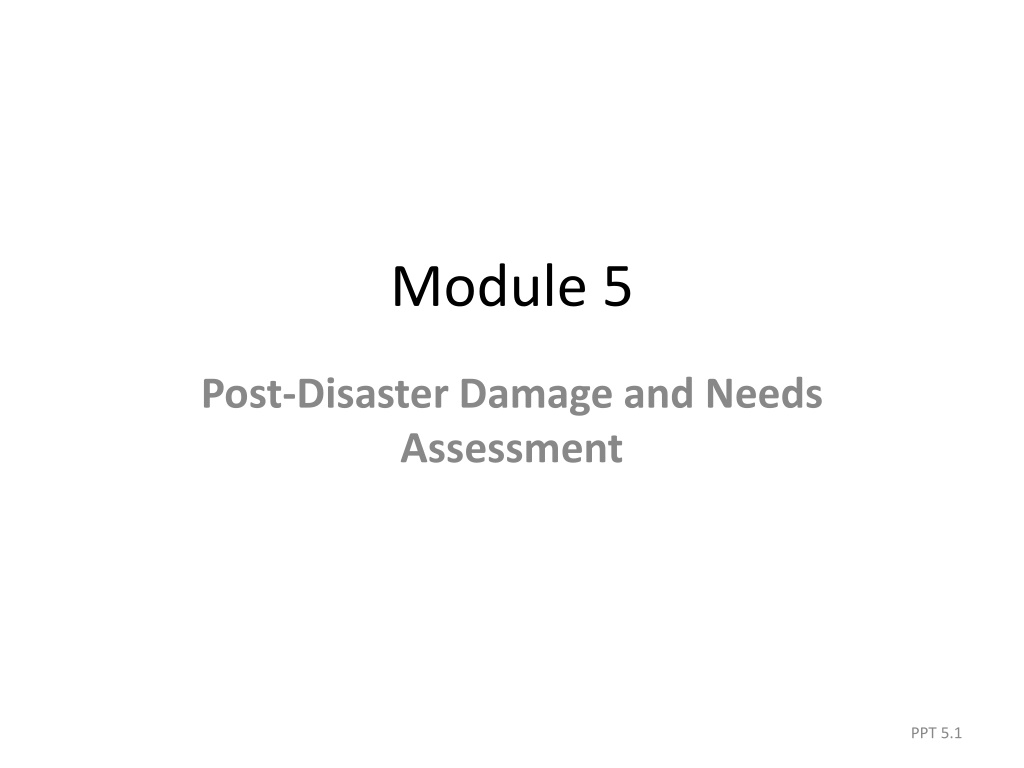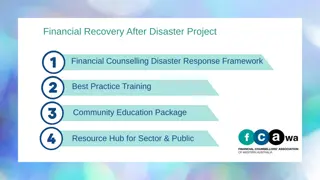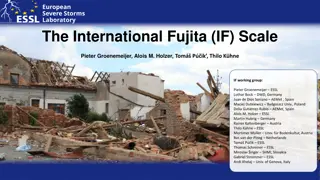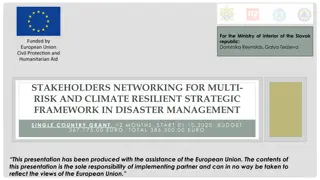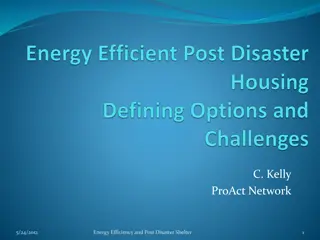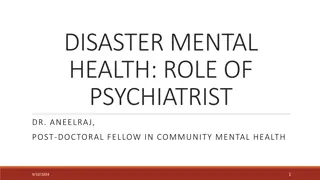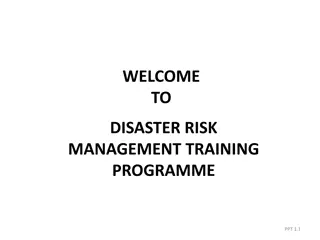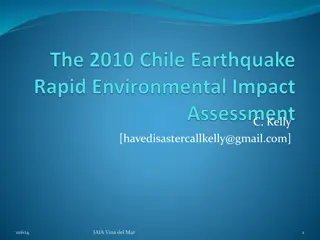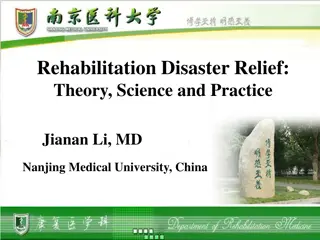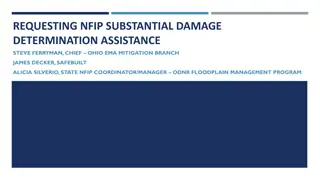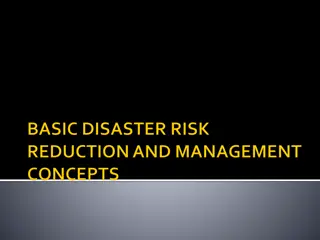Understanding Post-Disaster Damage and Needs Assessment
Post-Disaster Damage and Needs Assessment (PDNA) is a vital protocol for evaluating damage, identifying needs, and planning recovery after disasters. This module covers the objectives, activities, and core elements of PDNA, emphasizing country-led assessments and coordinated recovery planning. PDNA aims to assess the impact on infrastructure, economy, and society, identify recovery priorities, estimate financial requirements, and mobilize resources for reconstruction. Through systematic assessment and collaboration with international partners, PDNA facilitates sustainable recovery and risk reduction efforts.
Download Presentation

Please find below an Image/Link to download the presentation.
The content on the website is provided AS IS for your information and personal use only. It may not be sold, licensed, or shared on other websites without obtaining consent from the author. Download presentation by click this link. If you encounter any issues during the download, it is possible that the publisher has removed the file from their server.
E N D
Presentation Transcript
Module 5 Post-Disaster Damage and Needs Assessment PPT 5.1
Module 5: Performance Objectives At the end of this module, trainees will be able to: state the objectives of a Post-Disaster Damage and Needs Assessment (PDNA) explain the core elements of PDNA assess in a methodical way the damage and economic losses following a disaster in their administrations and allocation and/or aid comprehensive recovery project the financial for required a PPT 5.2
Activities in this Module Go through the presentations Carry out an exercise to calculate the damage and economic losses following a disaster in their respective administrations using PDNA format Complete Progress Test Q 5.1 PPT 5.3
What is PDNA? It is a protocol/mechanism for joint assessment and recovery planning following a disaster. EU, World Bank and UNDG took this initiative in the year 2008 to support the affected countries better with a coordinated approach for recovery. Assessment is led by the country affected by the disaster and supported by the UN system, EU, World Bank, other participating international donors, financial institutions & NGOs PPT 5.4
Objectives of PDNA To support country-led assessments and to initiate a coordinated recovery planning process through an inter-institutional coordinated approach. To assess the damage and losses from the disaster, particularly to human lives, physical infrastructure, productive sectors and the economy To evaluate the effect of the disaster on governance, social processes and access to goods and services To identify the needs for a comprehensive recovery and reconstruction leading back to a sustainable development process by focusing on risk reduction and build back better. PPT 5.5
Objectives of PDNA (contd.) To define a strategy for recovery, including outlining of priority needs, recovery interventions, expected outputs and the cost of recovery and reconstruction To estimate the financial resources required for recovery and reconstruction and suggest how such resources can be mobilised through local, national and international sources. Following slides on CoreElements will explain how a PDNA is carried out and its core elements. PPT 5.6
Core elements of PDNA The core elements of a PDNA are 1. Collection of pre-disaster baseline data on people, property, infrastructure etc. to compare them with the post-disaster conditions to evaluate the magnitude and scale of disaster. 2. Evaluation of the (a) disaster effects and (b) disaster impact in each sector to determine the overall recovery needs. (Damage to Postal sector is included under the head Infrastructure Communications . Later, slides under PDNA for the postal sector give more details on this.) PPT 5.7
Core Elements (contd.) (a) Disaster effects: i. Damage to infrastructure and physical assets ii. Disruption of access to goods and services like post office counter and delivery services, housing, healthcare, drinking water etc. iii. Governance and decision-making processes like disruption to administrative Headquarters, basic community life etc. iv. Increased risks and vulnerabilities following the disaster i.e. assessment of what risks increase as a result of the disaster and how and what additional threats increase the vulnerability of people. E.g. fire after earthquake functioning of PPT 5.8
Core Elements (contd.) (b) Disaster impact: i. Economic impact (losses) at macro and micro levels ii. Human development impact impact on the quality of human life in medium and long term PDNA follows a human recovery approach which is a people-centred approach, development impact of disasters, distinct needs and priorities of women, girls, boys and men of all ages, support to recovery efforts of affected population etc. focusing on human PPT 5.9
Core Elements (contd.) 3. Prioritisation of these recovery needs by preparing a Recovery Strategy 4. The Recovery Strategy should define clear objectives, appropriate interventions to meet priority recovery needs, expected outputs and overall intended outcome, and finally it should outline the implementation arrangements 5. Providing a basis for resource mobilisation for recovery and reconstruction through local, national and international sources An illustrative PDNA format is at Handout H 5.1 PPT 5.10
PDNA for the Postal Sector Damage Infrastructure Communications head in a PDNA Damage in postal infrastructure sector (e.g. airport facilities, distribution centres, postal vehicles, postal buildings) and in postal products (e.g. mail, stamps, stocks) are generally included in the PDNA UPU Regional Project Coordinator is to be associated while carrying out the PDNA Based on the PDNA, UPU helps countries to get funds for the postal sector from donor countries/ institutions, and also provides assistance directly under ESF & QSF to postal sector is included under PPT 5.11
UPU Assistance following a disaster There are mainly two sources of funds: (i) ESF: Emergency & Solidarity Fund (ii) QSF: Quality of Service Fund To get assistance from ESF and/or QSF, postal administrations will need to carry out PDNA in coordination with the UPU Regional Project Coordinator and submit the same to UPU PPT 5.12
UPU Assistance (contd.) PDNA information needed by UPU: 1. Baseline pre-disaster data/information on the Post, including the number and size of occupied facilities, assets and equipment 2. Extent of impact on 3Ps (People, Product, Property), including estimated damage from the disaster and losses related to business interruptions 3. A recovery strategy for physical assets, infrastructure and resumption of service [The PDNA format at H 5.1 with suitable changes as necessary may be used to provide the required information.] PPT 5.13
UPU Assistance (contd.) ESF Assistance is given for large scale disasters like flood, earthquakes, hurricanes, fires etc. Primarily used for short-term actions aimed at restoring basic postal services and for preparation of plans for reconstruction of damaged infrastructure Handout H 5.2 may be seen as an example of ESF assistance from UPU QSF Administrations can ask for and get funds on a fasttrack basis from their QSF balance to repair critical international mail infrastructure damaged in a disaster. PPT 5.14
Disaster Recovery Framework (DRF) This is again a post-disaster needs assessment exercise like the PDNA; but it (DRF) goes much beyond PDNA EU, UNDP and World Bank s GFDRR had supported the development of DRF, which builds on information generated through a PDNA and similar such assessments to: - assist Governments in planning for a resilient post- disaster recovery; and - to bring international and national stakeholders together behind recovery effort. a single government-led PPT 5.15
DRF (contd.) While PDNA primarily provides damage and loss estimates and quantifies needs, DRF goes further and Articulates vision for recovery Defines recovery strategy Prioritises actions, sequences actions Fine-tunes planning, aligns recovery measures with on-going development plans Provides guidance on financing, implementing and monitoring the recovery Provides for self-evaluation improvement for continuous PPT 5.16
DRF (contd.) DRF is based on good practices compiled from disaster recovery experiences of many countries For postal administrations comprehensive PDNA can serve the purpose to arrive at their requirements and needs figures for rehabilitation and recovery however, a PPT 5.17
Exercise on PDNA Trainees can now refer to Handout H 5.1 and carry out a PDNA for the postal sector following any large-scale disaster that had taken place in their respective countries in the past The template at H 5.1 can be modified/ improved upon as required PPT 5.18
Progress Test Q 5.1 PPT 5.19
